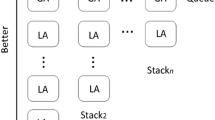Abstract
Path-finding is a fundamental problem in computer games, and its efficiency is mainly determined by the number of nodes it will expand. A* algorithm is unsuitable for path-finding on large map under limited computer sources and real-time demand, because the number of nodes it will expand grows fast with the size of the search space. HPA* can greatly improve the efficiency by generating abstract graph of the given map to memorize the map information before doing pathfinding. Through evenly partitioning the map as preprocessing, it can also reduce the influence of terrain factor on the output. As a result, it finds near optimal paths instead of optimal ones. And the evenly partition on the map doesnt consider the terrain distribution, which may still cause resource waste to some extent. In this paper, we present DT-HPA* (Hierarchical Path-Finding A* based on Decision Tree), a hierarchical path-finding approach on the map which has been divided by decision tree. This approach views each point on the map as an instance, and divides the map according to cut-points of continuous valued decision tree. The result of division is that the map is cut into some rectangular regions in different size, and retains the regions contain a kind of terrain. The experimental results show that, compared to HPA*, DT-HPA* can find more optimal paths with fewer detected nodes.
Access this chapter
Tax calculation will be finalised at checkout
Purchases are for personal use only
Preview
Unable to display preview. Download preview PDF.
Similar content being viewed by others
References
Hart, P.E., Nilsson, N.J., Raphael, B.: A Formal Basis for the Heuristic Determination of Minimum Cost Paths. IEEE Transactions on Systems Science and Cybernetics, 100–107 (1968)
Patrick, L.: A* Path-finding for Beginners, http://www.policyalmanac.org/games/aStarTutorial.html (updated July 18, 2005)
Koening, S., Likhachev, M., Furcy, D.: Lifelong planning A*. Artificial Intelligence Journal 155(1-2), 93–146 (2004)
Kenny, D., Nash, A., Koenig, S.: Theta*: Any-Angle Path Planning on Grids. Journal of Artificial Intelligence Research 39, 533–579 (2010)
Samet, H.: An overview of Quad trees, Octrees, and Related hierarchical data structures. NATO ASI Series, vol. 40, pp. 51–68 (1988)
Yahja, A., Stentz, A., Singh, S., et al.: Framed-Quad tree path planning for mobile robots operating in sparse environments. In: Proceedings of IEEE Conference on Robotics and Automation (ICRA), Leuven, Belgium (May 1998)
Choset, H., Lynch, K.M., Hutchinson, S., et al.: Principles of Robot Motion. MIT Press (2004)
Demyen, D., Buro, M.: Efficient triangulation-based path-finding. In: Proceedings of AAAI (2006)
Sturtevant, N., Buro, M.: Partial pathfinding using map abstraction and refinement. In: Proceedings of AAAI, pp. 1392–1397 (2005)
Bulitko, V., Sturtevant, N.: Graph abstraction in real-time heuristic search. Journal of Artificial Intelligence Research 30, 51–100 (2007)
Botea, A., Muller, M., Schaeffer, J.: Near optimal hierarchical path-finding. Journal of Game Development 1, 7–28 (2004)
Rabin, S.: A* Aesthetic Optimizations. Game Programming Gems, 264–271 (2000)
Jansen, M.R., Buro, M.: HPA* Enhancements. In: Proceedings of the Third Artificial Intelligence and Interactive Digital Entertainment Conference, Stanford, California, USA, pp. 84–87 (2007)
Harabor, D., Botea, A.: Hierarchical path planning for multi-size agents in heterogeneous environments. In: IEEE Symposium on Computational Intelligence and Games, pp. 258–265 (2008)
Quinlan, J.R.: Improved use of continuous attributes in C4.5. Journal of Artificial Intelligence Research 4, 77–90 (1996)
Breiman, L., Friedman, J.H., Olshen, R.A., et al.: Classification and Regression Tree. Wadsworth International Group, Monterey (1984)
Author information
Authors and Affiliations
Editor information
Editors and Affiliations
Rights and permissions
Copyright information
© 2012 Springer-Verlag Berlin Heidelberg
About this paper
Cite this paper
Li, Y., Su, LM., Li, WL. (2012). Hierarchical Path-Finding Based on Decision Tree. In: Li, T., et al. Rough Sets and Knowledge Technology. RSKT 2012. Lecture Notes in Computer Science(), vol 7414. Springer, Berlin, Heidelberg. https://doi.org/10.1007/978-3-642-31900-6_32
Download citation
DOI: https://doi.org/10.1007/978-3-642-31900-6_32
Publisher Name: Springer, Berlin, Heidelberg
Print ISBN: 978-3-642-31899-3
Online ISBN: 978-3-642-31900-6
eBook Packages: Computer ScienceComputer Science (R0)




